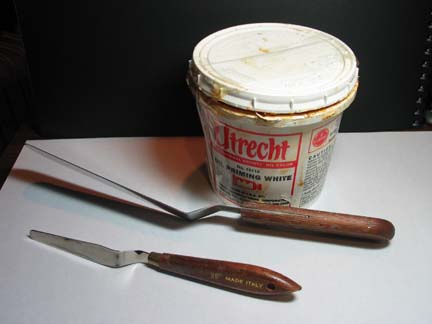Several readers asked more questions about the steps following the rabbit skin glue application during the process of priming linen.
After the glue has dried, usually 24 hours is a good bet, I sand the surface of the linen very lightly with a fine grit sandpaper block. If you run the palm of your hand over the surface, you will feel the rough threads that lift and dry during the sizing process. You just need to knock these off with the sanding. Afterward, run your palm over the surface and you will feel when it is smooth and the roughness is gone.
Using a step down knife you will now be able to prime the linen. Many different products are excellent for this process. I use lead primer so I always wear protective gloves. I prefer the primer from Robert Doak but there are other excellent ones also such as Utrecht.
The primer is very thick as it comes from the container, like a thick paste, which is OK. The theory is to scrape on a very thin layer just to cover the surface and fill the interstices of the linen's texture. The step down knife is very useful here because the primer will glide smoothly across the surface and your fingers will be protected from the goop.
Remember two or three thin layers are way better than one thick layer. I keep scraping all the excess off and putting it back in the can, so it never gets too thick. After the entire surface is covered, lay the canvas flat and let it dry for several days. I always do one more layer and let the canvas cure for at least 2 to 3 weeks. At this point, I paint on some kind of low oil color like burnt or raw umber, let this dry, and then it is ready to use.
Does any one else have a favorite technique or product?


Nice post. Thanks for shairing that